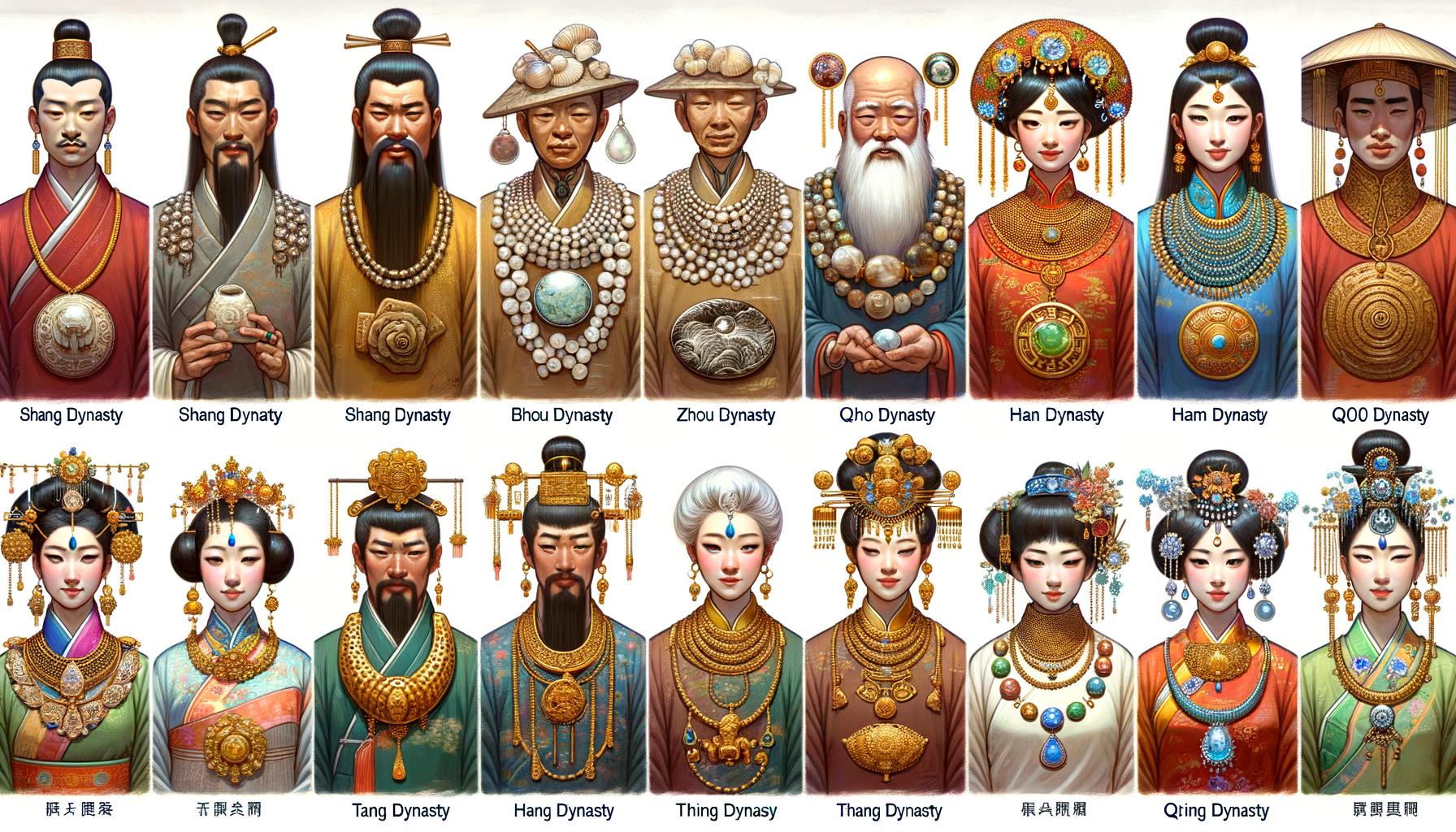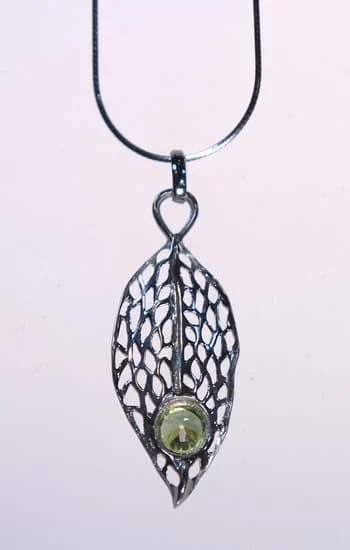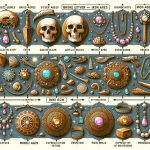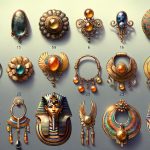The evolution of jewelry in Chinese dynasties traces a fascinating journey through time, reflecting the rich cultural heritage and intricate artistry that have characterized China for millennia. Jewelry in Chinese culture has always been much more than mere ornamentation; it is a powerful symbol of social status, spiritual beliefs, and artistic achievements.
Each dynasty brought its unique influences and advancements to jewelry-making, resulting in an extraordinary tapestry of designs that continue to inspire admiration and respect. By exploring the historical context of Chinese jewelry, we can gain deeper insights into how these exquisite pieces epitomize China’s enduring legacy.
From the ancient Shang Dynasty’s ritualistic jade and bronze adornments to the elaborate gold filigree creations of the Tang Dynasty, each period offered distinctive contributions to the world of jewelry. As Chinese civilization flourished and expanded, so too did the craftsmanship involved in creating these precious artifacts.
The early reliance on locally-sourced materials soon gave way to incorporating exotic gemstones and innovative techniques introduced via trade routes like the Silk Road. These developments not only enhanced the beauty and complexity of the jewelry but also served as a testament to China’s growing interaction with other cultures.
Understanding the evolution of jewelry in Chinese dynasties requires not just an appreciation for their aesthetic value but also a recognition of their symbolic meanings. Throughout various dynasties, certain motifs such as dragons, phoenixes, and floral patterns maintained deep cultural significance, often embodying concepts like power, immortality, and prosperity.
By examining these symbols within their historical frameworks, we reveal layers of meaning that offer glimpses into the values and beliefs held by ancient Chinese societies. This reverence for symbolism continues today as modern designers draw inspiration from traditional motifs while blending them with contemporary elements, ensuring that this timeless charm remains vibrant in today’s jewelry trends.
The Early Beginnings
Materials Used: Jade, Bronze, and Animal Bones
The Shang Dynasty marked one of the earliest periods where jewelry began to emerge as a significant cultural artifact in China. A variety of materials were utilized to create these early adornments, primarily jade, bronze, and animal bones. Jade, in particular, held a revered status due to its durability, subtle sheen, and perceived spiritual properties.
Artisans meticulously carved this gemstone into intricate shapes for personal ornamentation as well as for ceremonial tools and objects. Bronze was also extensively used for crafting jewelry items such as bracelets and rings, displaying a remarkable level of metallurgical skill for the time.
Symbolic Meanings and Ritualistic Uses
Jewelry during the Shang Dynasty wasn’t merely for aesthetic purposes; it was deeply embedded with symbolic meanings and utilized in various ritualistic contexts. The items often displayed motifs that represented power, spirituality, and connections to the divine world. For instance, jade ornaments were believed to protect against evil spirits and provide a conduit for spiritual communication with ancestors. Animal bones too were crafted into amulets that signified protection and strength derived from nature’s creatures.
Artistic Styles and Techniques From the Shang Period
The artistic styles of Shang Dynasty jewelry exhibited an emerging complexity despite the rudimentary tools available at that time. Techniques such as carving intricate designs on jade or casting detailed bronze pieces indicated high levels of craftsmanship. These artisans showcased early forms of engraving techniques which would significantly influence later dynastic periods. Their work set a foundation upon which future generations built more elaborate designs, leading to what we understand today about the evolution of jewelry in Chinese dynasties.
Elegance and Innovation
The Zhou Dynasty heralded a significant era for the evolution of jewelry in Chinese dynasties. One of the notable changes during this period was the introduction of gold and silver, which marked a departure from previous reliance solely on jade, bronze, and animal bones. These precious metals brought an entirely new dimension to jewelry making, allowing for greater intricacy and variety in design. Craftsmen began to experiment with combining different metals, enhancing durability and aesthetic appeal.
In terms of design evolution, the Zhou Dynasty is distinguished by its intricate patterns and novel themes. Artisans developed advanced techniques to create complex motifs often inspired by nature, such as swirling clouds or serpentine forms. This period also saw the emergence of more personalized jewelry pieces; amulets and ornaments were often custom-made to reflect individual tastes or social status. The level of detail and craftsmanship exceeded previous eras, underlining a society that increasingly valued artistic expression through wearables.
Jewelry played a crucial role in establishing social hierarchy during the Zhou Dynasty. The nobility adorned themselves with elaborate pieces indicating their higher status, using jewelry as both a symbol of power and a means to communicate cultural sophistication. Items such as headdresses with embedded jewels became popular among royals and high-ranking officials. Additionally, courtly settings often required specific types of ornamental adornments that highlighted one’s rank and influence within the societal structure.
| Key Aspect | Details |
|---|---|
| Materials Introduced | Gold and Silver |
| Design Evolution | Intricate patterns inspired by nature |
| Role in Social Hierarchy | Nobles used elaborate pieces to signal status |
Cultural Flourish
Influence of Silk Road Exchanges on Jewelry Styles
During the Han Dynasty, the establishment and expansion of the Silk Road had a profound impact on the evolution of jewelry in Chinese dynasties. This network of trade routes facilitated the exchange of goods, ideas, and artistic styles between China and distant civilizations such as Persia, India, and Rome. As a result, Han Dynasty jewelry started to reflect a fusion of cultural influences.
Ornamentation incorporated exotic gemstones such as sapphires and rubies that were introduced via these intercultural interactions. The new materials brought by the traders led to innovative designs that combined traditional Chinese elements with foreign aesthetics, broadening the artistic palette available to local artisans.
Advancements in Gemstone Usage and Metalwork
The Han period saw notable advancements in gemstone usage and metalwork techniques which significantly enhanced the artistry found within their jewelry. Craftsmen became adept at working with sophisticated metal alloys like gold and silver while also perfecting methods like engraving and gilding.
These techniques allowed for more elaborate and intricate pieces, utilizing primary gemstones such as jade-the quintessential symbol of virtue in Chinese culture-and newly introduced ones as well. The improved metalworking skills facilitated detailed representations of mythical creatures, floral patterns, and auspicious symbols within jewelry designs.
Jewelry as a Reflection of Prosperity and Artistic Expression
Jewelry during the Han Dynasty functioned not only as decorative items but also as indicators of one’s wealth and social status. The affluence brought about by flourishing trade reflected directly in personal adornment practices; individuals from affluent backgrounds would showcase luxurious pieces made from precious metals adorned with rare gems at social gatherings or important events.
Additionally, beyond just luxury items meant for display or status assertion, there was an intrinsic value placed on artistic expression through jewelry design. The motifs often incorporated significant cultural narratives or spiritual meanings stemming from Confucianism and Taoism that were prevalent during this era.
The blend between utilitarian craftsmanship coupled with deep symbolic representation highlights how richly intricate the evolution of jewelry in Chinese dynasties truly is-a testament to both aesthetic beauty and cultural profundity unique to each period’s historical context.
Artistry and Sophistication
The Tang Dynasty, often celebrated as the golden age of Chinese arts, witnessed an unparalleled blooming of creativity that extended to jewelry craftsmanship. The evolution of jewelry in Chinese dynasties reached a pinnacle during this period with innovations in techniques and designs that underscored the empire’s wealth and artistic prowess. Artisans employed sophisticated methods such as filigree, granulation, and cloisonné to create intricate pieces that adorned the elite.
Filigree involved meticulously crafting delicate metal threads into elaborate patterns, while granulation added texture through tiny metal spheres fused onto surfaces. Cloisonné, which saw its refinement during this time, used fine wires to create partitions filled with vibrant enamel. These methods resulted in intricate designs that were not only aesthetically pleasing but also demonstrated remarkable technical skill.
Popular motifs of Tang Dynasty jewelry included symbols infused with cultural significance such as phoenixes, dragons, and floral patterns. These designs were more than just decorative; they conveyed messages of power, prosperity, and longevity. For instance:
- The phoenix symbolized rebirth and immortality.
- Dragons represented strength and imperial authority.
- Floral motifs often embodied beauty and natural harmony.
Moreover, the Silk Road played a crucial role in this era by facilitating exchanges between East and West. This led to the incorporation of foreign elements into Chinese jewelry design, enriching the aesthetic vocabulary available to Tang artisans. The infusing of exotic materials such as precious stones from afar further heightened the opulence reflected in Tang Dynasty adornments.
The evolution of jewelry in Chinese dynasties during the Tang period reflects a confluence of artistic mastery and cultural amalgamation that continues to inspire contemporary designers today. The sophisticated techniques developed then still resonate within modern interpretations of traditional Chinese jewelry.
Refinement and Elegance
The Song Dynasty was a period of exquisite refinement and elegance, reflected vividly in its jewelry. This era continued and perfected many techniques inherited from previous dynasties while introducing subtle innovations that resonated with the unique cultural and intellectual climate of the time. Jewelry craftsmanship during the Song Dynasty reached new heights, characterized by meticulous attention to detail and a keen sense of aesthetics.
One notable advancement in this period was the increased use of pearls and jade. These materials were highly prized not only for their beauty but also for their symbolic meanings. Jade, revered for its purity and durability, was often carved into intricate shapes and incorporated into various types of ornaments.
Pearls, associated with wealth and nobility, adorned everything from hairpins to necklaces. The fusion of these materials in jewelry pieces underscored the desire for harmony and balance, echoing Confucian values that greatly influenced societal norms during this era.
Some key themes in Song Dynasty jewelry included:
- Subtle sophistication in design
- Increased use of naturalistic motifs such as flowers and animals
- Integration of literary elements, reflecting scholarly pursuits
Moreover, the evolution of jewelry in Chinese dynasties can clearly be seen from how careful artisans employed advanced techniques such as fine filigree work and delicate enameling to achieve superbly detailed creations. The role of jewelry extended beyond mere adornment; it mirrored the heightened appreciation for arts and culture prevalent during this epoch. Social status could be discerned through one’s choice of ornamentation, providing insight into both artistic expression and societal structures.
In addition to personal adornments, ceremonial items crafted from precious metals played significant roles in religious rituals and state ceremonies. These artifacts not only served decorative purposes but also embodied deeper spiritual meanings tied to prosperity, protection, and ethical virtues promoted by Confucianism. The blend of material exquisiteness with moral philosophy rendered Song Dynasty jewelry pieces as cherished heirlooms often passed down through generations.
Overall, the jewelry from this dynasty reflects a marriage between artistry and philosophical depth-hallmarks that continue to inspire modern interpretations today.
Innovation and Complexity
The Ming Dynasty marked a period of tremendous innovation and complexity in Chinese jewelry design, driven by a combination of traditional practices and new influences acquired through expanded trade networks. One notable advancement was the introduction of vibrant enameling techniques, which allowed for the creation of incredibly detailed, colorful pieces that seem to shimmer with life.
This period also saw an increased incorporation of imported gemstones such as sapphires, rubies, and emeralds into jewelry designs; these precious stones were often set in intricate gold settings that highlighted the Ming artisans’ exceptional metalworking skills.
In addition to adopting new materials, Ming jewelers experimented with hybrid styles that merged native Chinese aesthetics with motifs and forms brought from abroad. This era’s pieces often featured complex designs that combined traditional Chinese symbolism-such as dragons and phoenixes-with exotic elements like Persian floral patterns or Indian geometric shapes.
The resulting jewelry was not only visually captivating but also served as a cultural bridge, reflecting the dynamic exchange of ideas between China and other civilizations during this time.
Jewelry played a significant role in court life during the Ming Dynasty, serving as markers of social status and political power. High-ranking officials and members of the imperial family adorned themselves with elaborate headdresses, brooches, necklaces, and belt buckles encrusted with pearls and semi-precious stones that signified their rank.
These pieces were more than mere adornments; they were symbols of authority granted by the emperor himself. In this way, the evolution of jewelry in Chinese dynasties is vividly demonstrated through how personal adornment became intertwined with governance and ceremonial protocols during Ming rule.
| Element | Details |
|---|---|
| Techniques | Enameling, intricate gold settings |
| Materials | Sapphires, rubies, emeralds from imports |
| Influences | Persian floral patterns, Indian geometric shapes |
| Usage | Status symbols in court life & signifiers of political power |
Opulence and Diversity
During the Qing Dynasty, jewelry artistry reached unparalleled levels of opulence and diversity, reflecting the period’s social complexity and multicultural influences. The Qing rulers, originating from the Manchu ethnic group, infused their distinctive cultural heritage into Chinese jewelry designs, resulting in a rich tapestry of styles that blended traditional Han Chinese elements with Manchu motifs. This era marked an exuberant use of colors and intricate patterns that signified not just personal adornment but also conveyed deep cultural significance.
Influence of Manchu Culture
Manchu culture contributed significantly to the evolution of jewelry in Chinese dynasties during the Qing period. Manchu women, in particular, wore elaborate headpieces known as “dianzi,” adorned with pearls, jade, and precious stones that demonstrated their status and wealth. These headpieces often featured symbols such as dragons and phoenixes-recurrent motifs symbolizing imperial authority and prosperity. Furthermore, the incorporation of coral beads was prevalent among Manchu nobility; coral was believed to possess protective powers and bring good fortune.
Rich Use of Colors
The Qing dynasty era is notable for its vivid use of colors in its jewelry designs. Bright enamels in red, green, blue, and yellow were extensively used to create eye-catching accessories such as brooches, necklaces, and rings. Canton enamel-a cloisonné technique perfected during this time-became prominent for its ability to add vibrant hues to metal wires framed into various shapes. The popularity of this technique highlights how traditional methods were continually refined to achieve greater artistic sophistication.
Jewelry in Social Rituals
Jewelry played a crucial role in social rituals and ceremonial dress during the Qing Dynasty. Pieces like hairpins (bijia), earrings (erhuan), and finger coverings (jiaozhi) were integral parts of formal attire at court.
Each piece often had specific meanings or was used during particular events; for example, filigree gold hairpins studded with gemstones would be worn by brides during wedding ceremonies as symbols of fertility and marital bliss. Additionally, emperors gifted elaborately designed jewelry pieces as tokens reinforcing alliances or rewarding loyalty within the court circle.
Through these diverse elements-be it through material usage or symbolic interpretation-the Qing Dynasty left a lasting impression on the landscape of Chinese jewelry design by bringing together opulent artistry with cultural depth.
The Symbolism Behind Chinese Jewelry
The use of symbolism in Chinese jewelry has deep roots, reflecting the cultural and spiritual values that have permeated centuries of dynastic rule. One of the most prominent symbols is the dragon, which represents power, strength, and good luck. Historically, dragon motifs were often reserved for emperors and nobility, signifying their supreme status and divine right to rule. Jewelry pieces featuring dragons were not just decorative but also served as amulets believed to protect against evil and bring prosperity.
Another frequently used symbol in Chinese jewelry is the phoenix, which epitomizes rebirth, immortality, and grace. Often paired with the dragon to symbolize imperial power and harmony between yin and yang energies, phoenix-adorned jewelry was highly prized among women of nobility.
The motif is particularly noted for its intricate designs in necklaces, earrings, and headdresses from various dynasties. During special ceremonies or royal events, these pieces were worn to emphasize the wearer’s noble lineage and role within the societal hierarchy.
Jade is another emblematic feature with profound symbolic meanings in Chinese jewelry. Throughout different dynasties, jade was believed to embody purity, moral integrity, and eternal life. This exquisite stone was often carved into pendants depicting characters or scenes from mythology and folklore-each carrying unique significance.
Mythical creatures such as qilin (a type of unicorn), auspicious clouds signifying good fortune, or characters for longevity are all examples incorporated into jade artifacts. Given its strong cultural resonance, jade continues to hold a pivotal role in both historical collections and modern interpretations of Chinese ornamentation.
| Symbol | Meaning |
|---|---|
| Dragon | Power, strength, good luck |
| Phoenix | Rebirth, immortality, grace |
| Jade Characters | Purity, moral integrity,eternal life |
Symbols like these accentuate how deeply intertwined spiritual beliefs are with artistry in Chinese jewelry design across various eras. The evolution of jewelry in Chinese dynasties reveals not just changes in materials or techniques but also an enduring commitment to encapsulating metaphysical ideals through wearable artforms.
Modern Interpretations
Modern Chinese jewelry designers continue to draw deep inspiration from the past, infusing their creations with elements that reflect the evolution of jewelry in Chinese dynasties. Artists today maintain a reverence for traditional motifs such as dragons, phoenixes, and intricate geometrical patterns, while experimenting with contemporary aesthetics and innovative techniques.
- Traditional Symbols Reimagined: Many modern pieces retain classic symbols into their designs. For instance, dragon motifs are often seen on pendants and rings but are rendered in sleek minimalistic styles suitable for modern tastes. The phoenix continues to symbolize rebirth and eternity in new designs but may be paired with materials like titanium or platinum to offer a fresh spin.
- Fusion of Techniques: There’s also a noticeable blend of age-old craftsmanship with cutting-edge technology. Traditional methods such as cloisonn? and filigree are utilized alongside laser cutting and 3D printing. This amalgamation allows for intricate detailing that pays homage to historical artistry while introducing new textures and forms.
In addition to technical innovation, modern designers look towards the emotional and cultural resonance of historical pieces. By referencing periods like the Tang Dynasty’s golden age or the Qing Dynasty’s opulence, they embed their creations with rich storytelling characteristics. Jewelry aficionados appreciate pieces not just for their beauty but also for their narrative power conveying centuries of history. The evolution of jewelry in Chinese dynasties is an ongoing story interpreted through each new generation’s lens.
Moreover, environmental consciousness in contemporary craftsmanship has led to ethical sourcing practices heavily rooted in respect for nature-a nod perhaps to ancient reverence seen especially during periods like the Song Dynasty when Confucian values influenced design principles. Sustainable materials like ethically sourced jade and recycled metals are chosen to align both traditional reverence for natural resources and modern ecological sensibilities.
Conclusion
The journey through the evolution of jewelry in Chinese dynasties reveals a profound narrative that weaves together artistry, cultural identity, and historical significance. From the early Shang Dynasty’s jade and bronze artifacts to the Ming Dynasty’s introduction of complex designs incorporating both imported and traditional styles, Chinese jewelry has continually evolved while maintaining its deep cultural roots.
This evolutionary timeline highlights not just the skill and creativity of ancient craftsmen but also the rich tapestry of societal values, trade influences, and technological advancements that shaped each era’s adornments.
Preserving traditional craftsmanship is paramount as it encompasses more than techniques; it embodies cultural heritage and artistic legacy. Modern designers draw inspiration from these timeless pieces, integrating historical motifs with contemporary styles to create unique expressions that honor their origins.
This fusion respects the evolution of jewelry in Chinese dynasties while ensuring that ancestral methods are not forgotten but rather celebrated in new forms. In this way, modern iterations serve as bridges between past and present, paying homage to tradition while pushing forward into innovative territories.
The allure of Chinese jewelry across ages lies in its ability to narrate stories through intricate designs and symbolic motifs such as dragons, phoenixes, and lotus flowers-each carrying profound meanings rooted in Chinese mythology and folklore. This enduring appeal transcends time, affirming its role not just as ornamental art but as a testament to cultural continuity.
As we look toward the future, appreciating these beautiful legacies reminds us of the importance of sustaining our connection to history through artful expressions that endure for generations.
Frequently Asked Questions
What Is the History of Jewelry in China?
The history of jewelry in China dates back several thousand years, woven into the fabric of its rich cultural heritage. From the Neolithic period through various dynastic eras, Chinese jewelry evolved significantly, reflecting social structures, religious beliefs, and artistic advancements. Jade has been highly prized since ancient times, symbolizing purity and moral integrity.
During the Shang and Zhou Dynasties, jewelry not only served as personal adornment but also denoted status and power within the hierarchical society. The Tang Dynasty marked a golden age for art and culture, including jewelry making, where goldsmithing techniques flourished and influences from the Silk Road introduced new designs and materials.
What Kind of Jewelry Did Ancient China Wear?
Ancient Chinese people adorned themselves with an array of exquisite jewelry pieces that expressed both their cultural values and artistic inclinations. Among these were intricately carved jade ornaments such as pendants, bracelets, and hairpins—the latter called “buyao,” designed to sway elegantly with movement.
Gold was crafted into elaborate earrings, necklaces, and rings often featuring intricate motifs like dragons or phoenixes to symbolize imperial power or good fortune. Additionally, items such as silver waistbands and ornamental belts showcased meticulous craftsmanship while signifying social rank.
What Materials Were Used in Ancient Chinese Jewelry?
In ancient China, a variety of materials were skillfully employed to create stunning pieces of jewelry that held both aesthetic appeal and symbolic meaning. Jade stood out as one of the most cherished materials due to its revered qualities representing virtue and immortality; nephrite jade was extensively used before jadeite jade gained prominence during later dynasties.
Precious metals like gold and silver were also prominent in creating luxurious adornments for the elite class; these metals were often combined with gemstones such as turquoise, agate, carnelian, pearls, amber, coral, clay beads dyed in vivid colors brought life into simpler designs worn by common folk synthetic glass which resembled natural material eventually became during certain periods enhance overall presentation some ornate items adding to complex history scenarios shaping fascinating lineage Chinese jewelry intricacies specificity cultural attributes significance each piece possessor uncovering eras they belong forming narrative elucidated uniqueness tradition innovation spans generations eternity

Welcome to my jewelry blog! My name is Sarah and I am the owner of this blog.
I love making jewelry and sharing my creations with others.
So whether you’re someone who loves wearing jewelry yourself or simply enjoys learning about it, be sure to check out my blog for insightful posts on everything related to this exciting topic!





